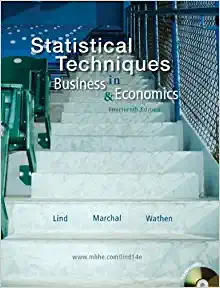Question
TRUE / FALSE. Write 'T' if the statement is true and 'F' if the statement is false. 1) M1 is the most liquid form of
TRUE/FALSE. Write 'T' if the statement is true and 'F' if the statement is false.
1) M1 is the most liquid form of money.
2) Checking accounts perform the same market functions as cash.
3) Only the federal government can create money.
4) To calculate required reserves, you must multiply the required reserve ratio by the
amount of transactions account balances on the bank's balance sheet.
5) If the minimum reserve ratio is 20 percent, then $1 of reserves can support a maximum
of $10 more in transactions deposits.
6) Each bank can lend an amount equal to its total reserves and no more.
7) A reduction in the minimum required reserve ratio will reduce the money multiplier.
8) When cash or coins are deposited in a transactions account at a bank, the money supply
immediately increases by the amount of the deposit multiplied by the money multiplier.
9) When you pay off a loan at a bank, the money supply becomes smaller.
10) Each bank may lend money greater than its excess reserves.
11) The banking system creates additional money by making loans equal to total reserves.
12) If banks are willing to make loans and consumers and businesses are willing to borrowmoney, this constrains the money supply.
13) Regulations are a major constraint on deposit creation.
14) When someone takes out a loan at a bank, the money supply becomes smaller.
15) Without money, the process of acquiring goods and services would be much more efficient.
16) Transactions accounts allow for direct payment to a third party.
17) When cash or coins are deposited in a transactions account at a bank, the size of M1
changes.
18) All checking accounts are transaction accounts.
1) The Federal Open Market Committee impacts the economy through open marketoperations.
2) The reserve requirements and discount rates affect M2 but do not have much impact onM1.
3) The ability of the banking system to make loans depends on excess reserves and thereserve requirement.
4) By raising the required reserve ratio, the Fed can immediately reduce the lendingcapacity of the banking system.
5) A change in the discount rate changes the size of the money multiplier.
6) The most profitable way for a bank to maintain the minimum required reserves is to holdlarge amounts of excess reserves.
7) If banks do not have enough reserves to satisfy the reserve requirement, they can borrowadditional reserves in the federal funds market.
8) Open market operations are the principal mechanism for directly altering the reserves ofthe banking system.
9) When the Fed buys bonds from the public, it decreases the flow of reserves to thebanking system.
10) The primary objective of Fed open market activity is to alter the price of bonds and their yields.
11) As the price of a bond rises, its yield rises.
12) When the Fed buys bonds, the money supply increases.
13) Increasing the reserve requirement reduces the money supply.
14) The globalization of money weakens the Fed's control over the money supply.
15) The Fed now targets the federal funds rate rather than the money supply.
1) The price of money is the nominal interest rate.
2) The federal funds rate reflects the cost for banks to borrow from other banks.
3) The success of Fed intervention depends in part on how closely changes in long-terminterest rates follow changes in short-term interest rates.
4) The liquidity trap exists because the lower portion of the money demand curve ishorizontal.
5) According to the equation of exchange, total spending will rise if the money supplydecreases and velocity is stable.
6) A horizontal aggregate supply curve causes higher inflation, rather than higher output, toresult from increases in the money supply.
7) Because monetarists believe that output is sensitive to changes in the money supply, theyrecommend that the money supply be allowed to grow at a steady and predictable rate.
8) How well fiscal policy works depends on how much the velocity of money can bechanged by government tax and spending decisions.
MULTIPLE CHOICE. Choose the one alternative that best completes the statement or answers the question.
9) The quantity of money people are willing and able to hold at alternative interest rates,ceteris paribus, is known as the
A) Supply of money.
B) Equilibrium of money.
C) Demand for money.
D) None of the choices are correct.
10) If the Fed wants to increase AD, it should do which of the following?
A) Raise the required reserve ratio.
B) Conduct open market purchases.
C) Raise the discount rate.
D) Lower capital gains tax rates.
Step by Step Solution
There are 3 Steps involved in it
Step: 1

Get Instant Access to Expert-Tailored Solutions
See step-by-step solutions with expert insights and AI powered tools for academic success
Step: 2

Step: 3

Ace Your Homework with AI
Get the answers you need in no time with our AI-driven, step-by-step assistance
Get Started


